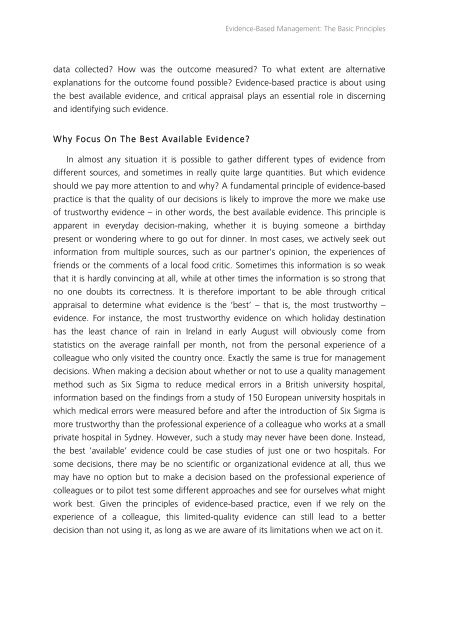In Search of Evidence
jqluvth
jqluvth
You also want an ePaper? Increase the reach of your titles
YUMPU automatically turns print PDFs into web optimized ePapers that Google loves.
<strong>Evidence</strong>-Based Management: The Basic Principles<br />
data collected? How was the outcome measured? To what extent are alternative<br />
explanations for the outcome found possible? <strong>Evidence</strong>-based practice is about using<br />
the best available evidence, and critical appraisal plays an essential role in discerning<br />
and identifying such evidence.<br />
Why Focus On The Best Available <strong>Evidence</strong>?<br />
<strong>In</strong> almost any situation it is possible to gather different types <strong>of</strong> evidence from<br />
different sources, and sometimes in really quite large quantities. But which evidence<br />
should we pay more attention to and why? A fundamental principle <strong>of</strong> evidence-based<br />
practice is that the quality <strong>of</strong> our decisions is likely to improve the more we make use<br />
<strong>of</strong> trustworthy evidence — in other words, the best available evidence. This principle is<br />
apparent in everyday decision-making, whether it is buying someone a birthday<br />
present or wondering where to go out for dinner. <strong>In</strong> most cases, we actively seek out<br />
information from multiple sources, such as our partner’s opinion, the experiences <strong>of</strong><br />
friends or the comments <strong>of</strong> a local food critic. Sometimes this information is so weak<br />
that it is hardly convincing at all, while at other times the information is so strong that<br />
no one doubts its correctness. It is therefore important to be able through critical<br />
appraisal to determine what evidence is the ‘best’ — that is, the most trustworthy —<br />
evidence. For instance, the most trustworthy evidence on which holiday destination<br />
has the least chance <strong>of</strong> rain in Ireland in early August will obviously come from<br />
statistics on the average rainfall per month, not from the personal experience <strong>of</strong> a<br />
colleague who only visited the country once. Exactly the same is true for management<br />
decisions. When making a decision about whether or not to use a quality management<br />
method such as Six Sigma to reduce medical errors in a British university hospital,<br />
information based on the findings from a study <strong>of</strong> 150 European university hospitals in<br />
which medical errors were measured before and after the introduction <strong>of</strong> Six Sigma is<br />
more trustworthy than the pr<strong>of</strong>essional experience <strong>of</strong> a colleague who works at a small<br />
private hospital in Sydney. However, such a study may never have been done. <strong>In</strong>stead,<br />
the best ‘available’ evidence could be case studies <strong>of</strong> just one or two hospitals. For<br />
some decisions, there may be no scientific or organizational evidence at all, thus we<br />
may have no option but to make a decision based on the pr<strong>of</strong>essional experience <strong>of</strong><br />
colleagues or to pilot test some different approaches and see for ourselves what might<br />
work best. Given the principles <strong>of</strong> evidence-based practice, even if we rely on the<br />
experience <strong>of</strong> a colleague, this limited-quality evidence can still lead to a better<br />
decision than not using it, as long as we are aware <strong>of</strong> its limitations when we act on it.


